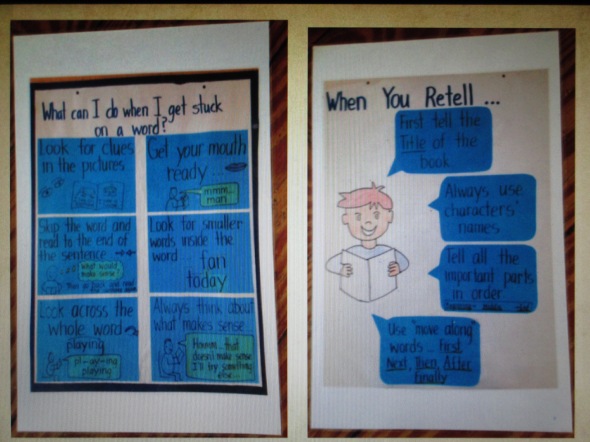Bringing Charts Home
Posted: November 10, 2015 Filed under: Uncategorized | Tags: agency, charts, communication, home-school 6 CommentsCreating and maintaining home-school connections is something most schools strive to put into place and keep going across the school year. Newsletters, memos, meet the teacher nights, conference days, report cards, and homework are some of the ways schools typically communicate with families. But even with all these efforts to partner with parents, parents can still feel sidelined, mere spectators in their child’s education. Helping parents communicate well with both their child and their child’s teacher is one way to invite parents into this world called school.
Learning the language of school is no easy task when you are not living and breathing it day in and day out. But guess who can be our home-school ambassadors? Our children! Yes, students can act as a conduit between what is going on in the classroom and home. And charts can help make sure this information is clearly transmitted. Charts can help parents learn the language of school.
Charts create a method of communication between teacher and parent as the child teaches the parent what the chart is about and what it teaches. Important vocabulary used in school is brought into the home so that a shared language and understanding can be developed. Not only do charts help familiarize parents with what’s going on in the classroom, they can provide specific strategies that parents can point to when trying to help their child with homework.
At PS 29 in Brooklyn, first grade teacher, Maureen Crowley, found that once she started sending copies of charts home her parents felt more connected and better understood what their children were learning as readers and writers. The charts provided a concrete tool they could draw upon when talking to their children about what they were working on in school. Instead of asking, “How was school today?” and getting the proverbial, “Nothing,” parents could now ask more specific questions, like, “Can you retell me one of the books you read today?” or “What did you do to revise your writing today?”
Another benefit of sending charts home with children is that it puts the child in charge of their learning. Each child becomes the expert, the one in charge of explaining and using the chart leading to increased agency. Charts sent home can anchor children in the work of school, even when they are at home. And charts provide children with a tool they can use to help themselves when stuck.
One way charts can become accessible in the home is to turn the refrigerator door into a bulletin board. Reading charts, writing charts, and personal word walls can be hung up with magnets. And since the kitchen is often the heart of the home it can spark some great conversations about what the child is working on in school.
Bringing charts home can also bring about other positive effects, such as children creating their own charts as needed. For example, when our editor, Zoe White’s daughter, Anna, was trying to get better at getting ready for school in the morning she decided to make a chart that she could use to make sure she didn’t forget anything in the often harried mornings before school. And the best part is that it worked!
Some ways to send charts home to share with families:
- Place charts in the homework folder
- Puts charts in reading baggies
- Add them to the shared reading folder along with the poems
- Include them in the class newsletter
- Post them on a class blog
- Tweet them out
Teach parents that the purpose for using charts is to teach ways to think: how to organize, be flexible, to plan, to observe, and to use models or mentors. Reinforce the fact that using charts is an act of problem solving, not cheating, and encourages risk-taking and a “can-do” attitude towards any challenge faced by their child. Charts teach, charts support, charts can make you smarter.
Happy Charting! And hoping to see many of you at NCTE in Minneapolis!
Marjorie & Kristi




